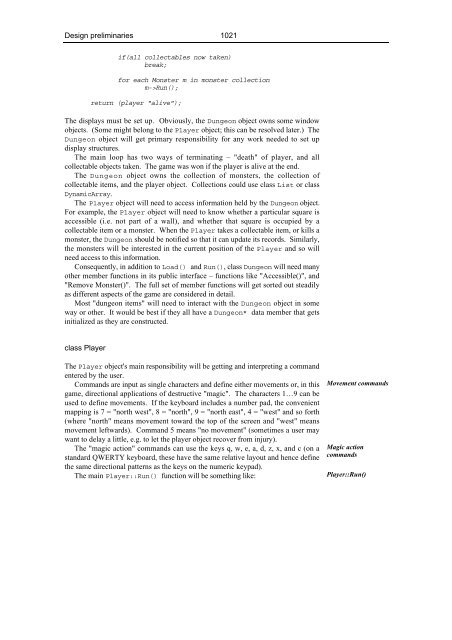29 The Power of Inheritance and Polymorphism
29 The Power of Inheritance and Polymorphism
29 The Power of Inheritance and Polymorphism
Create successful ePaper yourself
Turn your PDF publications into a flip-book with our unique Google optimized e-Paper software.
Design preliminaries 1021if(all collectables now taken)break;for each Monster m in monster collectionm->Run();return (player "alive");<strong>The</strong> displays must be set up. Obviously, the Dungeon object owns some windowobjects. (Some might belong to the Player object; this can be resolved later.) <strong>The</strong>Dungeon object will get primary responsibility for any work needed to set updisplay structures.<strong>The</strong> main loop has two ways <strong>of</strong> terminating – "death" <strong>of</strong> player, <strong>and</strong> allcollectable objects taken. <strong>The</strong> game was won if the player is alive at the end.<strong>The</strong> Dungeon object owns the collection <strong>of</strong> monsters, the collection <strong>of</strong>collectable items, <strong>and</strong> the player object. Collections could use class List or classDynamicArray.<strong>The</strong> Player object will need to access information held by the Dungeon object.For example, the Player object will need to know whether a particular square isaccessible (i.e. not part <strong>of</strong> a wall), <strong>and</strong> whether that square is occupied by acollectable item or a monster. When the Player takes a collectable item, or kills amonster, the Dungeon should be notified so that it can update its records. Similarly,the monsters will be interested in the current position <strong>of</strong> the Player <strong>and</strong> so willneed access to this information.Consequently, in addition to Load() <strong>and</strong> Run(), class Dungeon will need manyother member functions in its public interface – functions like "Accessible()", <strong>and</strong>"Remove Monster()". <strong>The</strong> full set <strong>of</strong> member functions will get sorted out steadilyas different aspects <strong>of</strong> the game are considered in detail.Most "dungeon items" will need to interact with the Dungeon object in someway or other. It would be best if they all have a Dungeon* data member that getsinitialized as they are constructed.class Player<strong>The</strong> Player object's main responsibility will be getting <strong>and</strong> interpreting a comm<strong>and</strong>entered by the user.Comm<strong>and</strong>s are input as single characters <strong>and</strong> define either movements or, in thisgame, directional applications <strong>of</strong> destructive "magic". <strong>The</strong> characters 1…9 can beused to define movements. If the keyboard includes a number pad, the convenientmapping is 7 = "north west", 8 = "north", 9 = "north east", 4 = "west" <strong>and</strong> so forth(where "north" means movement toward the top <strong>of</strong> the screen <strong>and</strong> "west" meansmovement leftwards). Comm<strong>and</strong> 5 means "no movement" (sometimes a user maywant to delay a little, e.g. to let the player object recover from injury).<strong>The</strong> "magic action" comm<strong>and</strong>s can use the keys q, w, e, a, d, z, x, <strong>and</strong> c (on ast<strong>and</strong>ard QWERTY keyboard, these have the same relative layout <strong>and</strong> hence definethe same directional patterns as the keys on the numeric keypad).<strong>The</strong> main Player::Run() function will be something like:Movement comm<strong>and</strong>sMagic actioncomm<strong>and</strong>sPlayer::Run()
















